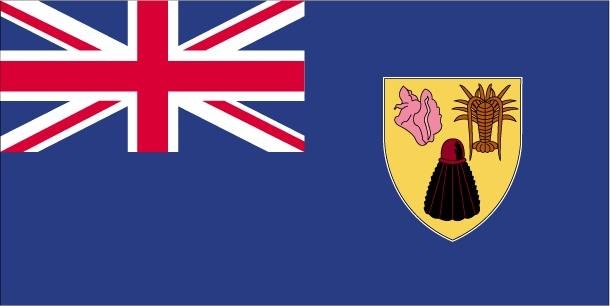125 Turks and Caicos (UK)

Blue with the flag of the UK in the upper hoist-side quadrant and the colonial shield centered on the outer half of the flag. The shield is yellow and displays a conch shell, a spiny lobster, and Turk’s cap cactus – three common elements of the islands’ biota.
Flag courtesy of the CIA World Factbook

Map courtesy of the CIA World Factbook

View of a wide sandy beach on Providenciales Island.
Photo courtesy of the CIA World Factbook
Last updated on March 20, 2025
Government
According to Britannica, the terms of the Turks and Caicos Islands Constitution Order of 2011 provide for a governor, who is to represent the British monarch as head of state and bear responsibility for external affairs, internal security, defense, international financial services, and the appointment of public officers. The executive branch also includes a cabinet, headed by the governor, that also includes a premier appointed by the governor, the attorney general, the deputy governor, and up to six other ministers, who are members of the legislature appointed by the governor on the advice of the premier. The unicameral legislature, the House of Assembly, consists of 21 members: 15 directly elected, four appointed, one ex officio (the attorney general), and the speaker, who is elected to that position by the legislature. The speaker can be either a member of the legislature not serving in the cabinet or a person from outside the legislature.
Civil Aviation Authority (CAA)
Turks and Caicos Islands Civil Aviation Authority (CAA) aims to provide the highest international standard in safety, quality and service in Civil Aviation Administration and Airport Operations. Air Safety Support International’s (ASSI) Policy Statements are contained in Part 1 of the Policy and Co-ordination Manual (PacMan). These are subject to ASSI’s formal consultation process and Directors of Civil Aviation (DCAs) will normally have 4 weeks to submit comments on a Policy Statement before it comes into effect. ASSI’s formal consultation process is set out in Policy Statement No 30 ‘Consultation’.
Airspace
SkyVector – Google Maps – ADS-B Exchange
ICAO countries publish an Aeronautical Information Publication (AIP). This document is divided into three parts: General (GEN), En Route (ENR) and Aerodromes (AD). ENR 1.4 details the types of airspace classes they chose to adopt from classes A through G.
Turks and Caicos AIP – password required
Drone Regulations
ASSI – Legal requirements for the operation of small unmanned aircraft in the UK Overseas Territories
Advanced Air Mobility (AAM) Regulations & Policies
None found by the author.
However, should you, the reader, happen to stumble across something to the contrary, please email the author at FISHE5CA@erau.edu and you may be mentioned in the ACKNOWLEDGEMENTS section of this book by way of thanks for contributing to this free eBook!
Advanced Air Mobility (AAM) News
None found by the author.
However, should you, the reader, happen to stumble across something to the contrary, please email the author at FISHE5CA@erau.edu and you may be mentioned in the ACKNOWLEDGEMENTS section of this book by way of thanks for contributing to this free eBook!
Short Essay Questions
Scenario-Based Question
You have been hired by a Drone Startup Company. Your boss has immediately assigned this job to you.
They need you to prepare a one-page memo detailing the legalities of using a drone to film the beaches in Turks and Caicos, pictured above.
They need you to mention any national laws and local ordinances.
They specifically want to know what airspace (insert pictures) you will be operating in and whether or not you need an airspace authorization.
Does it matter whether or not you are a citizen of the country?
Lastly, there is a bonus for you if, as you scroll through this chapter, you find any typos or broken links!
Short Essay Questions
- What are the drone categories?
- How is registration addressed?
- How is remote ID addressed?
- What are the model aircraft rules?
- What are the commercial drone rules?
- Are there waivers or exemptions to the rules? If so, for what?
- Would you share a link to an interactive airspace map?
- How is BVLOS addressed?
- How can you fly drones at night?
- How can you fly drones over people?
- Where do you find drone NOTAMs?
- What are the rules for drone maintenance?
- What are the rules for an SMS program?
- What are some unique rules not mentioned above?
- What are the C-UAS rules?
- What are the AAM rules?

